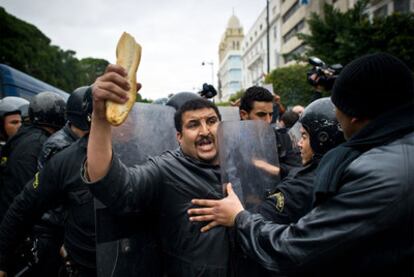Inflation jumps to levels last seen two years ago on electricity rate rise
Spanish economy underperforms Europe for first time since 1994
A hike in regulated electricity rates and higher food prices has driven Spanish inflation to its highest level in over two years despite domestic demand remaining anemic.
The National Statistics Institute (INE) said Tuesday the consumer price index (CPI) fell 0.7 percent in January from December as retailers slashed clothing and footwear prices during the traditional sales period at the start of the year. However, the annual rate accelerated to 3.3 percent from 3.0 percent.
The report coincided with figures from Eurostat, the European Union's statistics office, showing that the Spanish economy last year underperformed the rest of Europe for the first time since 1994 as activity contracted for the second year. The only other countries in the 27-member EU in which output fell were Greece, Ireland, Latvia and Romania.
The Economy Ministry attributed two-thirds of the hike in inflation last month to the 9-percent increase in electricity prices, with the rest due to higher tobacco, gas, travel and restaurant prices.
Tobacco prices rose as the government hiked taxes as part of its austerity drive to trim its gaping budget deficit. That caused the food and non-alcoholic drink component of the CPI to rise 2.1 percent from December.
Higher crude prices have also pushed up the cost of inputs to food production, such as fertilizers, pesticides and transport.
However, ongoing weakness in consumer spending as unemployment remains high should help keep inflation in check.
Spain's GDP fell 0.1 percent last year after contracting 3.8 percent the previous year when the country was still in the grip of its worst recession in several decades. GDP in the EU climbed 1.7 percent in 2010, Eurostat figures showed.
The government expects GDP to rise by 1.3 percent this year, but the International Monetary Fund expects growth of only 0.7 percent, with the government's ongoing austerity drive continuing to drag on the recovery.
The INE said underlying, or core inflation - which factors out volatile fresh-food and energy prices, and is considered a better gauge of the medium-term trend for consumer prices - rose to 1.6 percent in January from the previous month.
Economists expect the core rate to continue to rise in the coming months to about 2 percent before falling back again by the end of the year.
"Underlying inflation remains at moderate levels at 1.6 percent in January, and it is to be hoped, and this is what we are forecasting, that inflation as a whole falls," Spanish Economy Minister Elena Salgado told reporters in Brussels.
Funcas, the think-tank of Spain's association of savings banks, expects the headline rate of inflation to moderate to 1.9 percent by the end of the year.
The trend for inflation, however, will also be conditioned by crude oil prices, which have risen above 100 dollars again, in part due to geopolitical concerns raised by regime change in Egypt.
The harmonized index of consumer prices, which is used for comparative purposes with the euro-zone, climbed to 3.0 percent from 2.9 percent. That left the differential between the average rate in the single-currency zone and Spain at 0.6 percentage points.

Tu suscripción se está usando en otro dispositivo
¿Quieres añadir otro usuario a tu suscripción?
Si continúas leyendo en este dispositivo, no se podrá leer en el otro.
FlechaTu suscripción se está usando en otro dispositivo y solo puedes acceder a EL PAÍS desde un dispositivo a la vez.
Si quieres compartir tu cuenta, cambia tu suscripción a la modalidad Premium, así podrás añadir otro usuario. Cada uno accederá con su propia cuenta de email, lo que os permitirá personalizar vuestra experiencia en EL PAÍS.
¿Tienes una suscripción de empresa? Accede aquí para contratar más cuentas.
En el caso de no saber quién está usando tu cuenta, te recomendamos cambiar tu contraseña aquí.
Si decides continuar compartiendo tu cuenta, este mensaje se mostrará en tu dispositivo y en el de la otra persona que está usando tu cuenta de forma indefinida, afectando a tu experiencia de lectura. Puedes consultar aquí los términos y condiciones de la suscripción digital.








































